Study of Blockage Effects of Metro Train on Critical Velocity in Sloping Subway Tunnel Fires with Longitudinal Ventilation
Abstract
:1. Introduction
2. Numerical Model and Model Validation
2.1. Numerical Model and Boundary Conditions
2.2. Model Validation
3. Results and Discussions
3.1. Critical Velocity in the Blocked Zone of a Metro Train in Subway Tunnel Fires
3.2. Critical Velocity in the Unblocked Zones of a Metro Train in Subway Tunnel Fires
4. Conclusions
Author Contributions
Funding
Institutional Review Board Statement
Informed Consent Statement
Data Availability Statement
Conflicts of Interest
References
- Król, A.; Król, M. Study on hot gases flow in case of fire in a road tunnel. Energies 2018, 11, 590. [Google Scholar] [CrossRef] [Green Version]
- Li, Y.Z.; Lei, B.; Ingason, H. Study of critical velocity and backlayering length in longitudinally ventilated tunnel fires. Fire Saf. J. 2010, 45, 361–370. [Google Scholar] [CrossRef]
- Razus, D.; Giurcan, V.; Movileanu, C.; Mitu, M. Nitric oxide generation in N2-Diluted H2–N2O flames: A computational study. Processes 2022, 10, 1032. [Google Scholar] [CrossRef]
- Mitu, M.; Movileanu, C.; Giurcan, V. Deflagration characteristics of N2-Diluted CH4-N2O mixtures in the course of the incipient stage of flame propagation. Energies 2021, 14, 5918. [Google Scholar] [CrossRef]
- Weng, M.C.; Lu, X.L.; Liu, F.; Shi, X.P.; Yu, L.X. Prediction of backlayering length and critical velocity in metro tunnel fires. Tunn. Undergr. Space Technol. 2015, 47, 64–72. [Google Scholar] [CrossRef]
- Thomas, P.H. The Movement of Buoyant Fluid against a Stream and Venting of Underground Fire; Fire Research Note, No.351.; Fire Research Station: Watford, London, UK, 1958. [Google Scholar]
- Ye, K.; Zhou, X.; Yang, L.; Tang, X.; Zheng, Y.; Cao, B.; Peng, Y.; Liu, H.; Ni, Y. A multi-scale analysis of the fire problems in an urban utility tunnel. Energies 2019, 12, 1976. [Google Scholar] [CrossRef] [Green Version]
- Giurcan, V.; Mitu, M.; Movileanu, C.; Razus, D.; Oancea, D. Propagation Velocity of Flames in Inert-Diluted Stoichiometric Propane-Air Mixtures: Pressure and Temperature Dependence. Processes 2021, 9, 997. [Google Scholar] [CrossRef]
- Giurcan, V.; Razus, D.; Mitu, M.; Oancea, D. Numerical study of the laminar flame propagation in ethane-air mixtures. Open Chem. 2014, 12, 391–402. [Google Scholar] [CrossRef]
- Yan, G.F.; Wang, M.N.; Yu, L.; Duan, R.Y.; Xia, P.X. Effects of ambient pressure on smoke movement patterns in vertical shafts in tunnel fires with natural ventilation systems. Build. Simul. 2020, 13, 931–941. [Google Scholar] [CrossRef]
- Park, Y.; Lee, Y.; Na, J.; Ryou, H.S. Numerical study on the effect of tunnel aspect ratio on evacuation with unsteady heat release rate due to fire in the case of two vehicles. Energies 2019, 12, 133. [Google Scholar] [CrossRef] [Green Version]
- Zhang, X.C.; Zhang, Z.Y.; Tao, H.W. A numerical study on critical velocity and back-layering length with trains’ blockage in longitudinally ventilated tunnel fires. Tunn. Undergr. Space Technol. 2021, 116, 104093. [Google Scholar] [CrossRef]
- Zhang, S.G.; Cheng, X.D.; Yao, Y.Z.; Zhu, K.; Li, K.Y.; Lu, S.; Zhang, R.F.; Zhang, H.P. An experimental investigation on blockage effect of metro train on the smoke back-layering in subway tunnel fires. Appl. Therm. Eng. 2016, 99, 214–223. [Google Scholar] [CrossRef]
- Lee, Y.P.; Tsai, K.C. Effect of vehicular blockage on critical ventilation velocity and tunnel fire behavior in longitudinally ventilated tunnels. Fire Saf. J. 2012, 53, 35–42. [Google Scholar] [CrossRef]
- Yi, L.; Xu, Q.Q.; Xu, Z.S.; Wu, Z.D. An experimental study on critical velocity in sloping tunnel with longitudinal ventilation under fire. Tunn. Undergr. Space Technol. 2014, 43, 198–203. [Google Scholar] [CrossRef]
- Weng, M.C.; Lu, X.L.; Liu, F.; Du, C.X. Study on the critical velocity in a sloping tunnel fire under longitudinal ventilation. Appl. Therm. Eng. 2016, 94, 422–434. [Google Scholar] [CrossRef]
- Oka, Y.; Atkinson, G.T. Control of smoke flow in tunnel fires. Fire Saf. J. 1995, 25, 305–322. [Google Scholar] [CrossRef]
- Tang, W.; Hu, L.H.; Chen, L.F. Effect of blockage-fire distance on buoyancy driven back-layering length and critical velocity in a tunnel: An experimental investigation and global correlations. Appl. Therm. Eng. 2013, 60, 7–14. [Google Scholar] [CrossRef]
- Wu, Y.; Bakar, M.A. Control of smoke flow in tunnel fires using longitudinal ventilation systems–a study of the critical velocity. Fire Saf. J. 2010, 35, 363–390. [Google Scholar] [CrossRef]
- Shafee, S.; Yozgatligil, A. An analysis of tunnel fire characteristics under the effects of vehicular blockage and tunnel inclination. Tunn. Undergr. Space Technol. 2018, 79, 274–285. [Google Scholar] [CrossRef]
- Altay, M.; Surmen, A. Effect of the relative positions of vehicular blockage on the smoke flow behaviour in a scaled tunnel. Fuel 2019, 255, 115694. [Google Scholar] [CrossRef]
- Jiang, X.P.; Zhang, H.X.; Jing, A. Effect of blockage ratio on critical velocity in tunnel model fire tests. Tunn. Undergr. Space Technol. 2018, 82, 84–591. [Google Scholar] [CrossRef]
- Tang, F.; Cao, Z.L.; Chen, Q.; Meng, N.; Wang, Q.; Fan, C.G. Effect of blockage-heat source distance on maximum temperature of buoyancy-induced smoke flow beneath ceiling in a longitudinal ventilated tunnel. Int. J. Heat Mass Tran. 2017, 109, 683–688. [Google Scholar] [CrossRef]
- Tang, F.; Li, L.J.; Mei, F.Z.; Dong, M.S. Thermal smoke back-layering flow length with ceiling extraction at upstream side of fire source in a longitudinal ventilated tunnel. Appl. Therm. Eng. 2016, 106, 125–130. [Google Scholar] [CrossRef]
- Chow, W.K.; Gao, Y.; Zhao, J.H.; Dang, J.F.; Chow, C.L.; Miao, L. Smoke movement in tilted tunnel fires with longitudinal ventilation. Fire Saf. J. 2015, 75, 14–22. [Google Scholar] [CrossRef]
- Luo, J.L.; Xu, Z.S.; Li, F.L.; Zhao, J.M. Effect of vehicular blocking scene on smoke spread in the longitudinal ventilated tunnel fire. Case Stud. Therm. 2019, 14, 100495. [Google Scholar] [CrossRef]
- Tang, Z.; Gao, K.; Shan, Y.; Zhu, C.; Liu, Z.; Liu, Z. Study of the fire behavior of multilayer cables in a mine tunnel. Energies 2022, 15, 2059. [Google Scholar] [CrossRef]
- Kong, J.; Xu, Z.S.; You, W.J.; Wang, B.l.; Liang, Y.; Chen, T. Study of smoke back-layering length with different longitudinal fire locations in inclined tunnels under natural ventilation. Tunn. Undergr. Space Technol. 2021, 107, 103663. [Google Scholar] [CrossRef]
- Weng, M.C.; Yu, L.X.; Liu, F.; Nielsen, P.V. Full-scale experiment and CFD simulation on smoke movement and smoke control in a metro tunnel with one opening portal. Tunn. Undergr. Space Technol. 2014, 42, 96–104. [Google Scholar] [CrossRef]
- Zhang, S.; Yang, H.; Yao, Y.Z.; Zhu, K.; Zhou, Y.; Cheng, X.D. Numerical investigation of back-layering length and critical velocity in curved subway tunnels with different turning radius. Fire Technol. 2017, 53, 1765–1793. [Google Scholar] [CrossRef]
- Gannouni, S.; Maad, R.B. Numerical study of the effect of blockage on critical velocity and backlayering length in longitudinally ventilated tunnel fires. Tunn. Undergr. Space Technol. 2015, 48, 147–155. [Google Scholar] [CrossRef]
- Król, A.; Król, M. Some Tips on numerical modeling of airflow and fires in road tunnels. Energies 2021, 14, 2366. [Google Scholar] [CrossRef]
- Craig, M.; Asim, T. Numerical Investigations on the propagation of fire in a railway carriage. Energies 2020, 13, 4999. [Google Scholar] [CrossRef]
- McGrattan, K.; McDermott, R.; Hostikka, S.; Floyd, J. Fire Dynamics Simulator (Version 6) User’s Guide; NIST Special Publication 1019-6; National Institute of Standards and Technology: Gaithersburg, MD, USA, 2013. [Google Scholar]
- Huang, Y.B.; Li, Y.F.; Li, J.M.; Li, J.X.; Wu, K.; Zhu, K.; Li, H.H. Modelling and experimental investigation of critical velocity and driving force for preventing smoke backlayering in a branched tunnel fire. Tunn. Undergr. Space Technol. 2020, 99, 103388. [Google Scholar] [CrossRef]
- Blanchard, E.; Morlon, R.; Parent, G.; Fromy, P.; Boulet, P.; Borgiallo, D. Experimental study of the interaction between water sprays and smoke layer. Fire Technol. 2018, 54, 479–501. [Google Scholar] [CrossRef]
- Ji, J.; Guo, F.Y.; Gao, Z.H.; Zhu, J.P.; Sun, J.H. Numerical investigation on the effect of ambient pressure on smoke movement and temperature distribution in tunnel fires. Appl. Therm. Eng. 2017, 118, 663–669. [Google Scholar] [CrossRef]
- Gao, P.Z.; Liu, S.L.; Chow, W.K.; Fong, N.K. Large eddy simulations for studying tunnel smoke ventilation. Tunn. Undergr. Space Technol. 2004, 19, 577–586. [Google Scholar] [CrossRef]
- Hu, L.H.; Tang, F.; Yang, D.; Liu, S.; Huo, R. Longitudinal distributions of CO concentration and difference with temperature field in a tunnel fire smoke flow. Int. J. Heat Mass Tran. 2010, 53, 2844–2855. [Google Scholar] [CrossRef]
- Zisis, T.; Vasilopoulos, K.; Sarris, I. Numerical simulation of a fire accident in a longitudinally ventilated railway tunnel and tenability analysis. Appl. Sci. 2022, 12, 5667. [Google Scholar] [CrossRef]
- Fan, C.; Zhang, L.; Jiao, S.; Yang, Z.; Li, M.; Liu, X. Smoke spread characteristics inside a tunnel with natural ventilation under a strong environmental wind. Tunn. Undergr. Space Technol. 2018, 82, 99–110. [Google Scholar] [CrossRef]
- Li, L.; Cheng, X.; Cui, Y.; Li, S.; Zhang, H. Effect of blockage ratio on critical velocity in tunnel fires. J. Fire Sci. 2012, 30, 413–427. [Google Scholar] [CrossRef]
- Li, Y.Z.; Ingason, H. Effect of cross section on critical velocity in longitudinally ventilated tunnel fires. Fire Saf. J. 2017, 91, 303–311. [Google Scholar] [CrossRef]
- Olvera, H.A.; Choudhuri, A.R.; Li, W.W. Effects of plume buoyancy and momentum on the near-wake flow structure and dispersion behind an idealized building. J. Wind. Eng. Ind. Aerodyn. 2008, 96, 209–228. [Google Scholar] [CrossRef]
- Meng, N.; Yang, W.Y.; Xin, L.; Li, X.; Liu, B.B.; Jin, X.N. Experimental study on backlayering length of thermal smoke flow in a longitudinally ventilated tunnel with blockage at upstream of fire source. Tunn. Undergr. Space Technol. 2018, 82, 315–324. [Google Scholar] [CrossRef]
- Vega, M.G.; Díaz, K.M.; Oro, J.M.; Tajadura, R.B.; Morros, C.S. Numerical 3D simulation of a longitudinal ventilation system: Memorial tunnel case. Tunn. Undergr. Space Technol. 2008, 23, 539–551. [Google Scholar] [CrossRef]
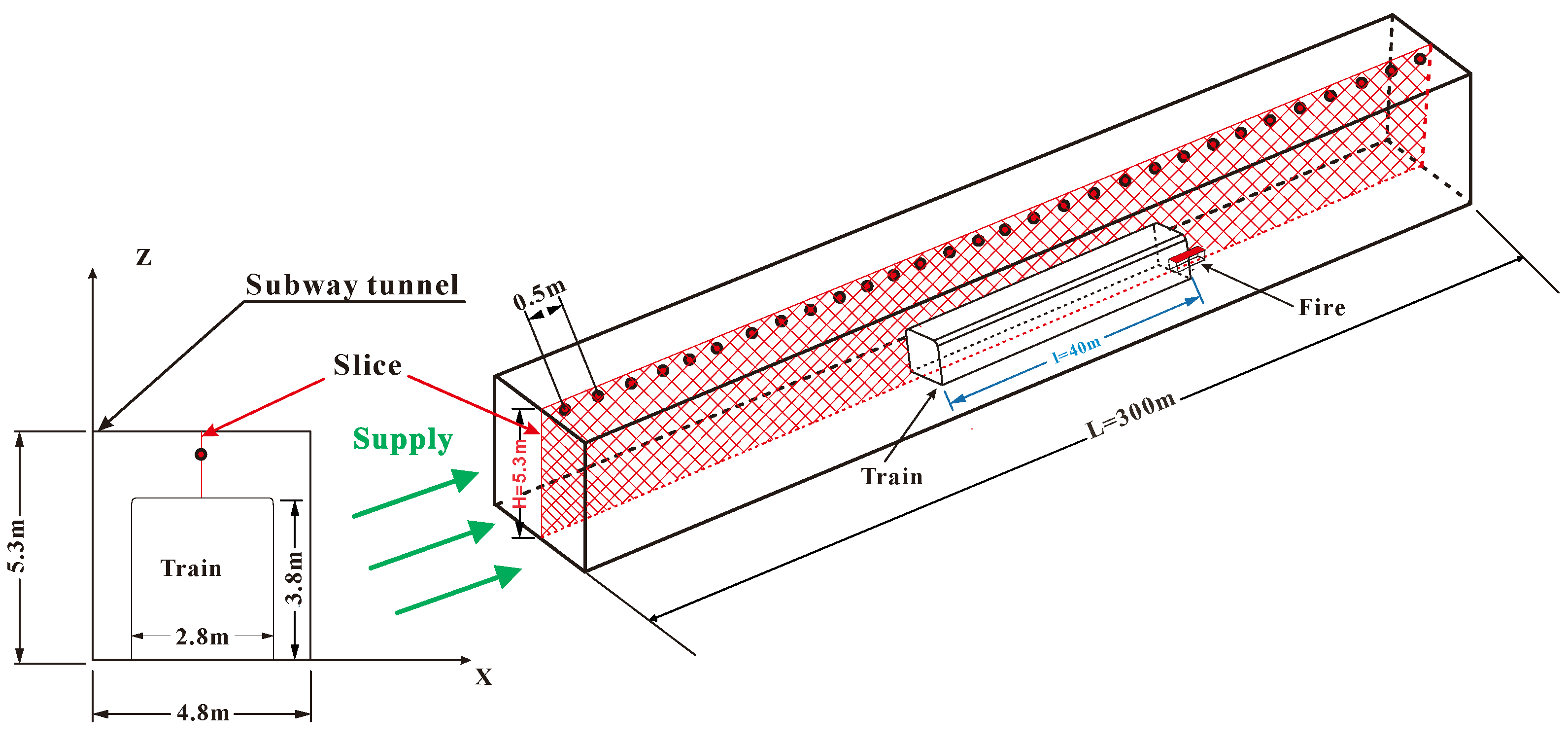
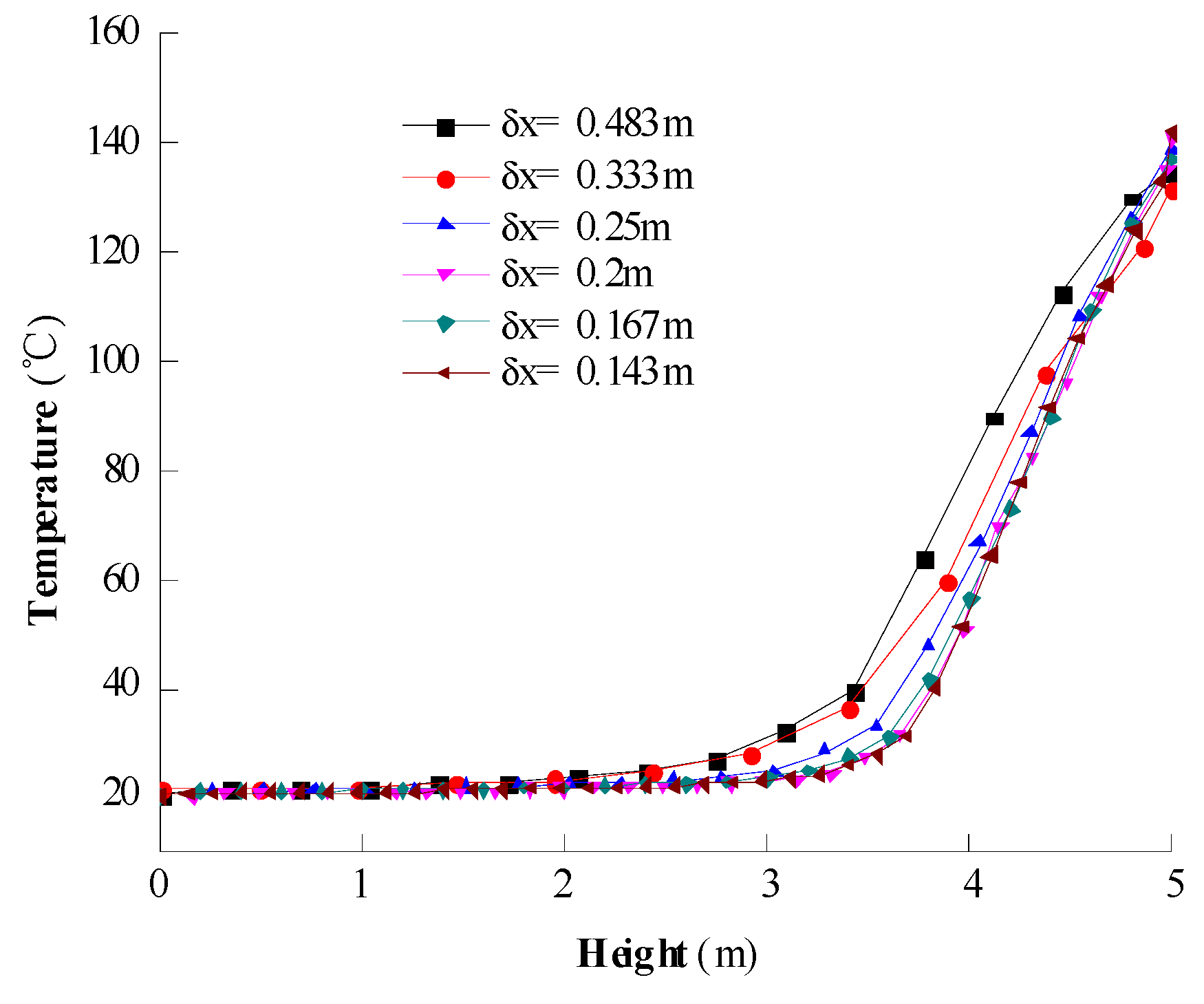
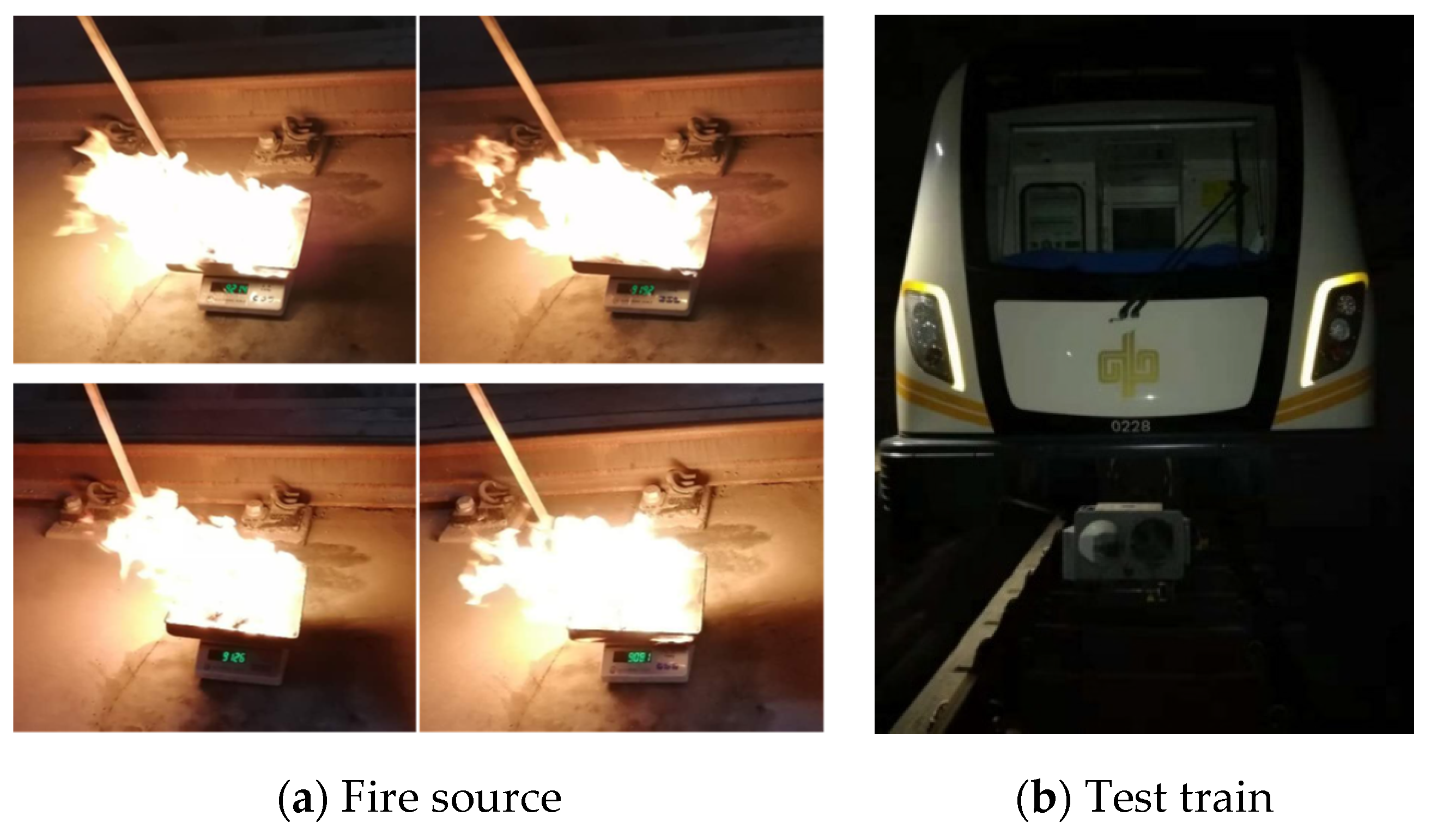
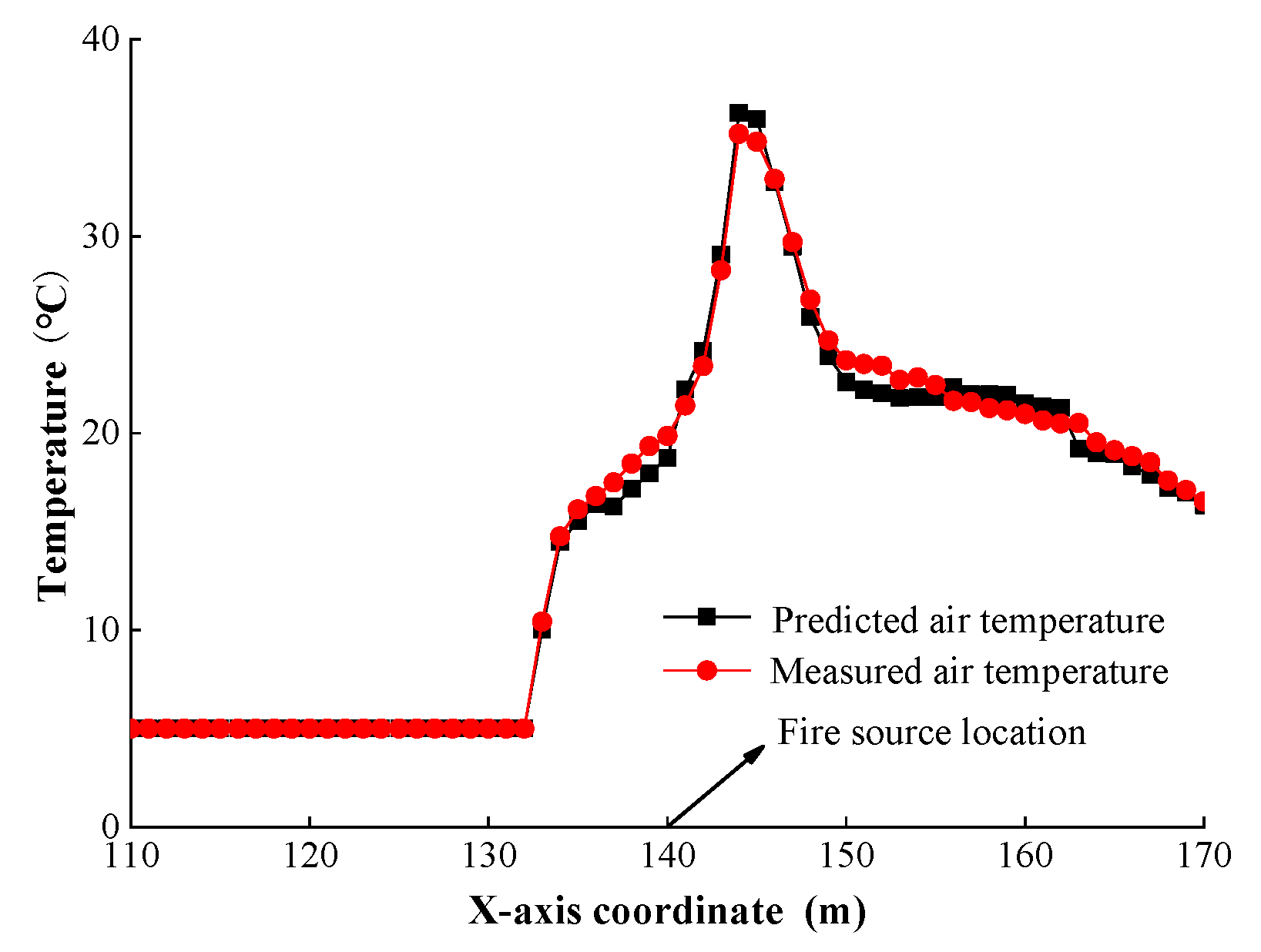
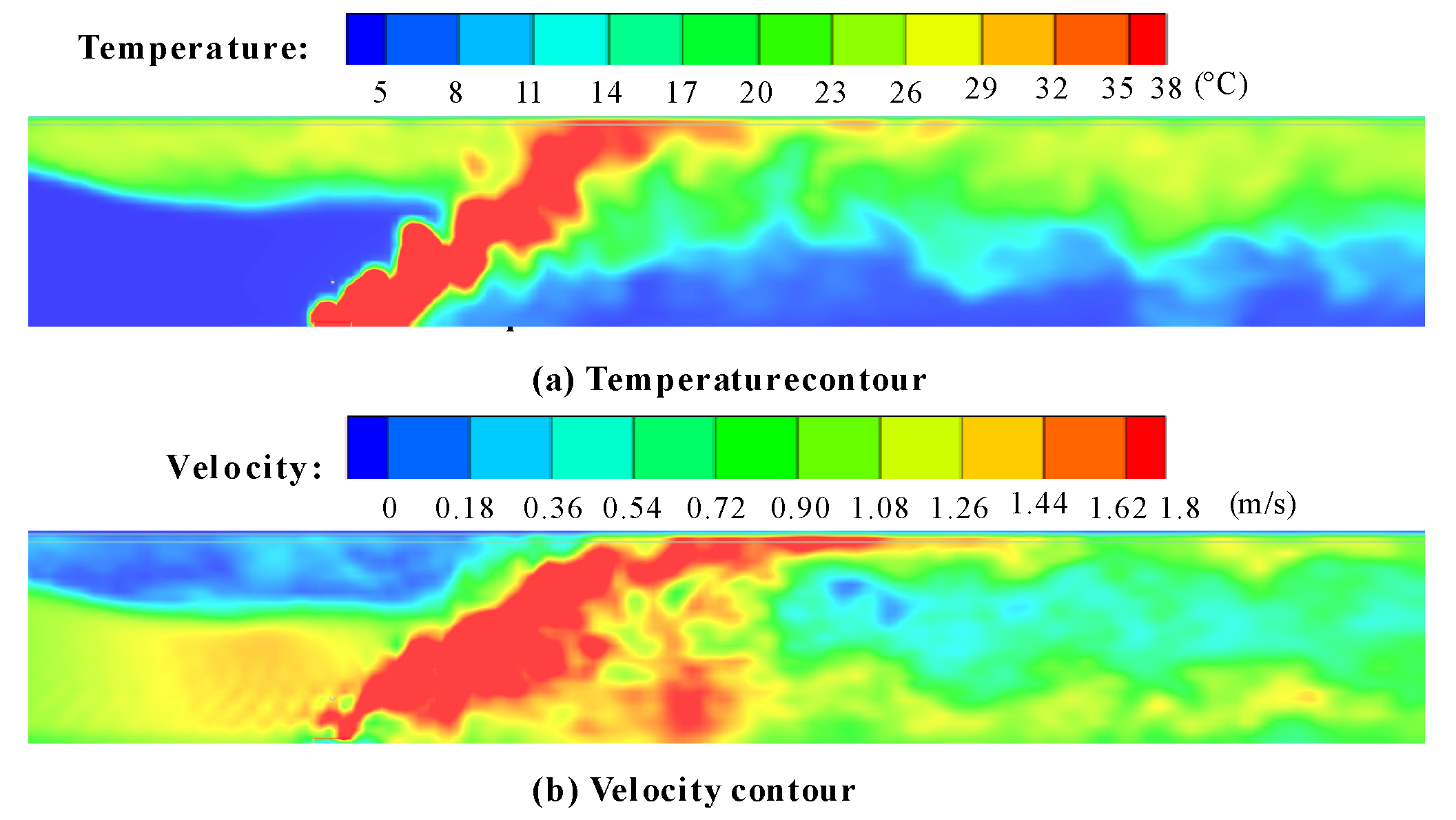

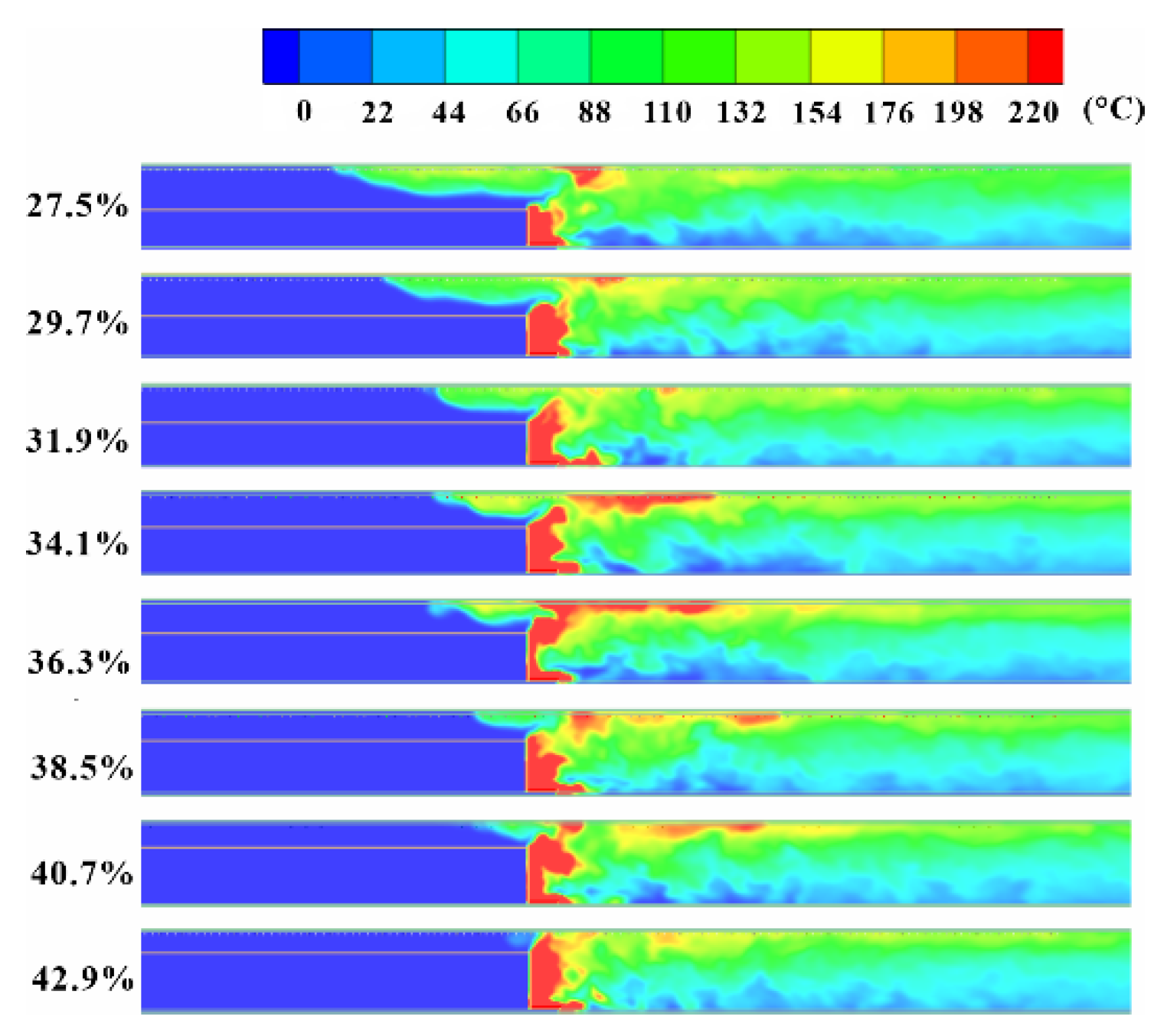



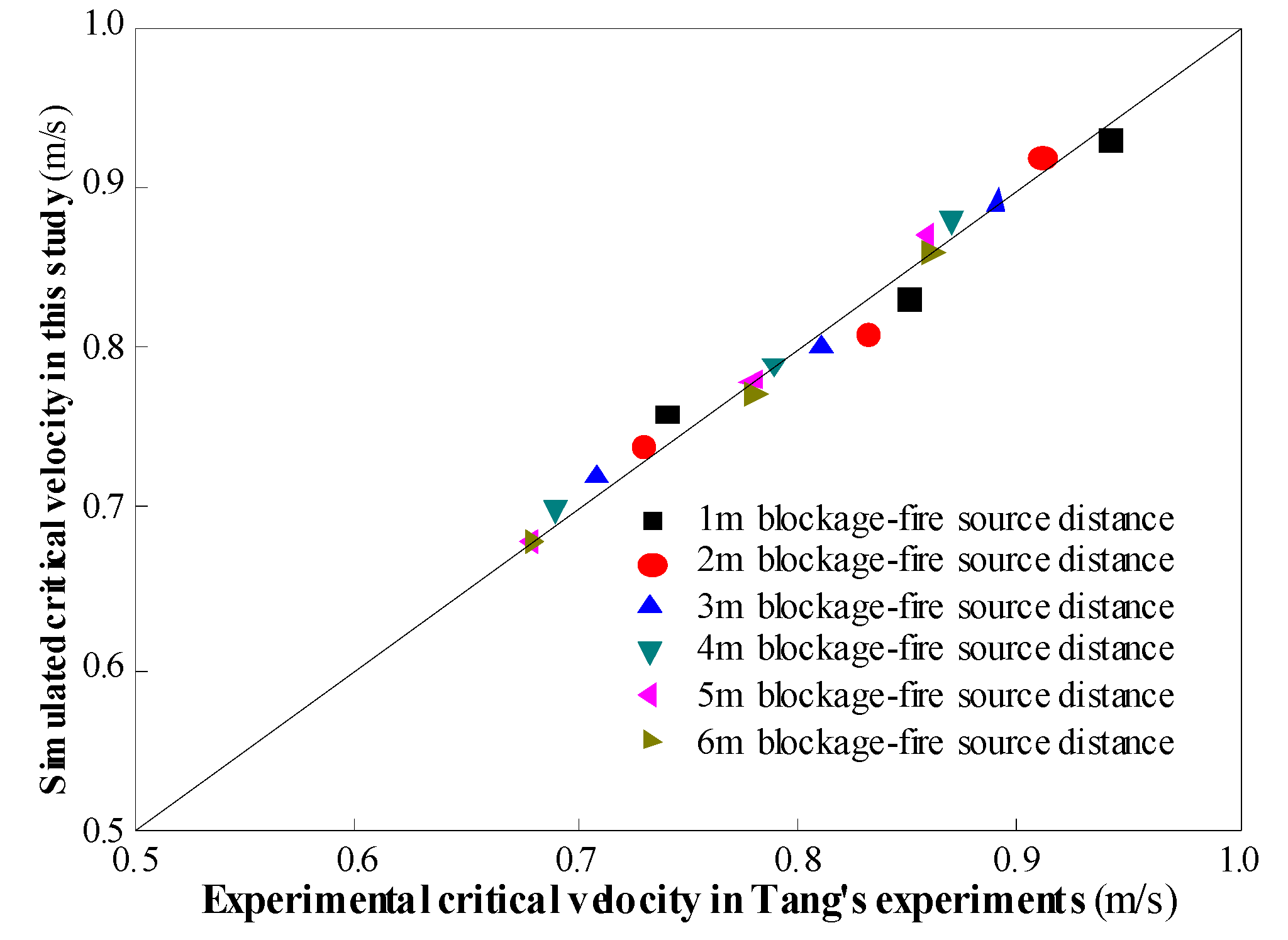


| Tunnel Width (m) | HRR (MW) | Slope (%) | Critical Velocity of Equation (8) (m/s) | Simulated Critical Velocity (m/s) | Relative Error (%) |
|---|---|---|---|---|---|
| 3.5 | 3 | 0 | 1.64 | 1.68 | 2.44 |
| 3.5 | 3 | −5 | 1.95 | 1.98 | 1.54 |
| 3.5 | 3 | 3 | 1.46 | 1.51 | 3.42 |
| 3.5 | 7.5 | 0 | 2.16 | 2.22 | 2.78 |
| 3.5 | 7.5 | −3 | 1.93 | 1.91 | −1.04 |
| 3.5 | 7.5 | 4 | 2.48 | 2.54 | 2.42 |
| 4.2 | 3 | 0 | 1.64 | 1.58 | −3.66 |
| 4.2 | 3 | 3 | 1.40 | 1.45 | 3.57 |
| 4.2 | 3 | −3 | 1.83 | 1.91 | 4.37 |
| 4.2 | 7.5 | 0 | 2.16 | 2.12 | −1.85 |
| 4.2 | 7.5 | 5 | 1.77 | 1.83 | 3.39 |
| 4.2 | 7.5 | −1 | 2.24 | 2.28 | 1.79 |
| No. | Blockage-Fire Distance (m) | Smoke Back-Layering Length (m) (Ventilation Velocity (m/s)) | Critical Velocity (m/s) |
|---|---|---|---|
| 1~5 | 2 | 4.0 (1.4), 1.7 (1.6), 1.5 (1.8), 1.0 (2), 0.6 (2.2) | 2.26 |
| 6~10 | 3 | 3.5 (1.4), 2.6 (1.6), 2.1 (1.8), 0.9 (2), 0.1 (2.2) | 2.22 |
| 11~15 | 4 | 4.6 (1.4), 3.3 (1.6), 2.2 (1.8), 0.8 (2), 0.2 (2.1) | 2.20 |
| 16~20 | 5 | 5.2 (1.4), 3.7 (1.6), 2.3 (1.8), 0.9 (2), 0.3 (2.1) | 2.18 |
| 21~25 | 6 | 6.5 (1.4), 4.5 (1.6), 2.2 (1.8), 1.2 (2), 0.2 (2.2) | 2.18 |
| 26~30 | 7 | 7.4 (1.4), 5.5 (1.6), 2.6 (1.8), 1.2 (2), 0 (2.2) | 2.16 |
| 31~35 | 8 | 8.5 (1.4), 6.3 (1.6), 3.3 (1.8), 1.3 (2), 0.1 (2.1) | 2.15 |
| 36~40 | 10 | 10.7 (1.4), 8.3 (1.6), 3.5 (1.8), 1.3 (2), 0.2 (2.1) | 2.14 |
| 41~45 | 12 | 12.4 (1.4), 8 (1.6), 5.8 (1.8), 1.4 (2), 0.5 (2.05) | 2.13 |
| 46~50 | 14 | 14.6 (1.4), 12.1 (1.6), 7.6 (1.8), 0.9 (2), 0.3 (2.1) | 2.12 |
| 51~55 | 16 | 15.7 (1.4), 13.8 (1.6), 8.9 (1.8), 1.4 (2), 0.3 (2.1) | 2.11 |
| 56~60 | 18 | 17.4 (1.4), 15.9 (1.6), 8.9 (1.8), 1.9 (2), 0.3 (2.1) | 2.1 |
| 61~65 | 20 | 19.3 (1.4), 17.4 (1.6), 11.8 (1.8), 1.2 (2), 0.5 (2.05) | 2.1 |
| 66~70 | 22 | 21.5 (1.4), 19.1 (1.6), 13.6 (1.8), 2.1 (2), 0.2 (2.1) | 2.1 |
| 71~75 | 24 | 23.4 (1.4), 21.9 (1.6), 14.9 (1.8), 1.6 (2), 0.5 (2.05) | 2.1 |
| 76~80 | 26 | 25.5 (1.4), 23.5 (1.6), 15.0 (1.8), 1.5 (2), 0.4 (2.05) | 2.1 |
| 81~85 | 28 | 27.3 (1.4), 25 (1.6), 16 (1.8), 1.5 (2), 0.6 (2.05) | 2.1 |
| 96~90 | 30 | 29.4 (1.4), 26.5 (1.6), 16.6 (1.8), 1.7 (2), 0.3 (2.05) | 2.1 |
Publisher’s Note: MDPI stays neutral with regard to jurisdictional claims in published maps and institutional affiliations. |
© 2022 by the authors. Licensee MDPI, Basel, Switzerland. This article is an open access article distributed under the terms and conditions of the Creative Commons Attribution (CC BY) license (https://creativecommons.org/licenses/by/4.0/).
Share and Cite
Wang, H.; Gao, H. Study of Blockage Effects of Metro Train on Critical Velocity in Sloping Subway Tunnel Fires with Longitudinal Ventilation. Energies 2022, 15, 5762. https://doi.org/10.3390/en15155762
Wang H, Gao H. Study of Blockage Effects of Metro Train on Critical Velocity in Sloping Subway Tunnel Fires with Longitudinal Ventilation. Energies. 2022; 15(15):5762. https://doi.org/10.3390/en15155762
Chicago/Turabian StyleWang, Haitao, and Huanhuan Gao. 2022. "Study of Blockage Effects of Metro Train on Critical Velocity in Sloping Subway Tunnel Fires with Longitudinal Ventilation" Energies 15, no. 15: 5762. https://doi.org/10.3390/en15155762
APA StyleWang, H., & Gao, H. (2022). Study of Blockage Effects of Metro Train on Critical Velocity in Sloping Subway Tunnel Fires with Longitudinal Ventilation. Energies, 15(15), 5762. https://doi.org/10.3390/en15155762







